Homemade Sanitary Pads
I learned about homemade cloth menstrual pads on a Christian Ladies’ message board in 2002. I had just been diagnosed with Poly Cystic Ovarian Syndrome or PCOS. Some of my symptoms were heavy, irregular and painful menses which left me feeling very much like the Woman in the New Testament with the issue of blood who touched Jesus’s garment to be healed. I even joked that I had periods of biblical proportions. Financially, we were in a tough spot at the time. Making decisions between groceries or sanitary pads is not a pleasant place to be so I was tickled when another mom shared a link to homemade pads. I ran some simple ones up on my sewing machine that day and have pretty much been a convert ever since.
Before the 20th Century, most women used cloth pads or “rags” during their menstruation. Disposable pads didn’t become common in America until after WW II. Among rural and low-income women they didn’t catch on until the 1960’s. As with diapers, there have always been people who prefer cloth to disposable. Disposable pads do not biodegrade very quickly. Plastic diapers and sanitary napkins are likely to be two of the most common artifacts that future archaeologists will find when excavating landfills from the 20 and 21 Centuries. I wonder what kind of commentary this will be on our present lifestyles? Only time will tell.
Outer Pad with Wings
Cut 2 with flap extended & 1 on fold with flap closed
Inner Pad
Cut 2 of flannel and 1 or 2 of filling or more flannel
Printing Instructions: Set Margins to 0.25 or 1/4 inch each.
To make your own sanitary napkins you need the following supplies: 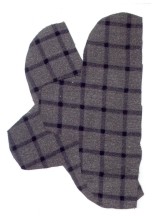
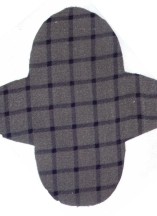
- A sewing machine with a zigzag stitch.
- Flannel: Old flannel shirts & baby blankets work beautifully but new flannel works fine too. Be sure to wash it in hot water before using to prevent shrinkage.
- Thread
- Snaps or Safety Pins
- Scissors
The Outer Pad
Begin by printing both of the patterns and cutting them out. The Inner Pad is a large oval. The Outer Pad is actually 2 patterns in 1. With the long straight side extended, it is the topside. You will need to cut 2 of these. With the long straight side folded in, it is the bottom side. Place the straight edge on a fold of fabric and cut 1 of these. Look at the pictures for examples. 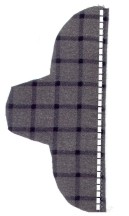
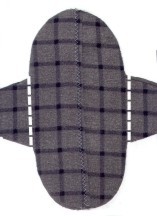
Make 1/2-inch hem down the long straight side of each of the 2 top pieces. Straight stitch or zigzag stitch this hem, as you prefer. Now arrange the 2 upper layers of the outer pad over the lower layer. The front hems should overlap slightly, or by about 1/2-inch.
Zigzag stitch around the outside twice. If desired you may straight stitch down the dotted lines shown on the picture to the right. This allows the inner pad to fit more securely inside the outer pad and also makes folding the wings a bit handier.
Some women apply a snap or button to the wings at this time. Place them at points “A” in the illustration. Velcro is not advisable because it has a tendency to chafe. Personally, I don’t <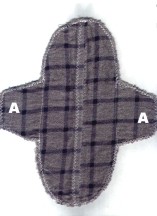 like
like to go through all the work of applying snaps or buttons so I use a safety pin instead. Large diaper safety pins work beautifully for pinning the wings together. To the right you will see a picture of the pad pinned closed. The wings fit around your underwear just like disposable pads with wings. Some women wear the pad with the pocket seam facing down, next to their underwear. Other women prefer the pad placed with the seam-side next to their skin. Try it both ways to see which you prefer.
to go through all the work of applying snaps or buttons so I use a safety pin instead. Large diaper safety pins work beautifully for pinning the wings together. To the right you will see a picture of the pad pinned closed. The wings fit around your underwear just like disposable pads with wings. Some women wear the pad with the pocket seam facing down, next to their underwear. Other women prefer the pad placed with the seam-side next to their skin. Try it both ways to see which you prefer.
The Inner Pad
The inner pad is the absorbent part of the sanitary napkin. It slips inside the pocket of the pad. The beauty of this is that you can use as many inner pads as necessary for the rate of your flow. During heavy times, or overnight, use 3 or 4 Inner pads. For a lighter flow use only 1 Inner pad. For a panty liner, use the outer pad without an inner pad. The reason you use several layers instead of 1 very thick layer is because several thinner layers are easier to wash and have a shorter drying time. Additionally, the many exterior surfaces of the pad layers makes them more absorbent than a single thick pad would be. 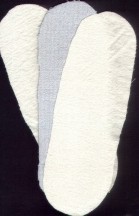
For the inner pad you want to cut at least 3 layers, maybe 4, depending on the thickness of your fabric. Use the same pattern for all of the layers.  Use flannel for the 2 exterior layers of the inner pad. Use 1 or 2 layers of flannel or terry cloth, cotton quilt batting or another absorbent material for the interior layers of the inner pad. I used old flannel shirts, a flannel baby blanket and an old towel for my fabric. The towel was ripped and had a few holes. I used it as the interior layer of my inner pads. The flannel baby blanket was the exterior of the inner pads, and the flannel shirt was the outer pad, the part with wings.
Use flannel for the 2 exterior layers of the inner pad. Use 1 or 2 layers of flannel or terry cloth, cotton quilt batting or another absorbent material for the interior layers of the inner pad. I used old flannel shirts, a flannel baby blanket and an old towel for my fabric. The towel was ripped and had a few holes. I used it as the interior layer of my inner pads. The flannel baby blanket was the exterior of the inner pads, and the flannel shirt was the outer pad, the part with wings.
After cutting out your layers for the inner pad stack them neatly. Zigzag stitch around the edges twice. Trim the edges if desired. I used dark thread in the picture so you could see it against the light flannel. Make 2 of these inner pads for each outer pad. They are very easy to cut and stitch, so you may want to make a few extras for heavy days.
After completing each part of the pad, slip the inner pad inside the pocket of the outer pad. Pin it in place and see how it feels. You will be surprised at how comfortable it is.
Washing and Maintenance
When you make your own pads you have to wash them instead of tossing them into the garbage. Keep a small bucket of water with a lid in the bathroom, preferably out of the reach of children and pets. Add a spoonful of vinegar if desired. Remove the inner pad from the outer pad. Soak the used pads in the bucket of water. Drain the water into the toilet before washing the pads. The water can also be used to water house plants because they like all the extra vitamins and minerals. Make sure you use cold water so that the stains will come out. I wash every morning. Some women stash all of the used pads in a pillowcase or plastic bag and wash them all at once when their period is over. I don’t do this because I have a washer in the house and I find it more sanitary to wash them every day. They can drip dry or machine dry.
If you do not have a washing machine, then they may be washed by hand. Run cold water over them in the bathtub to remove most of the blood. Place the pads in a medium bucket or tub. Add a little soap and cold water. Using a clean plunger, plunge the pads until they are as clean as you can get them. Plunge for a good 10 minutes for the best results. Rinse the pads well and squeeze them dry. Hang each pad by it’s own clothespin and they should dry pretty fast, even in the winter.
If you like, you can iron the pads, but do not use starch on them. Be careful not to use fabric softener either because it will make them less absorbent.
A No-Sew Alternative
If your sewing skills are lacking, or you simply do not want to go through the trouble of sewing your own pads you can try this instead. Purchase absorbent terry-cloth dishtowels. Wash them before using. Fold them into rectangles about 3 or 4-inches by 10 or 12 inches. Use safety pins to pin them into your underwear at both narrow ends (the front and the back). These are a bit bulkier than home-sewn pads. They are quite comfortable though, and are a legitimate alternative. They may be washed the same as home-sewn pads. I’ve also seen washcloths recommended. Fold them into thirds, or quarters (long ways) and fit them into your underwear. Apparently they stay in place without pinning because of the friction between the terry-cloth and underwear. For heavier flows fold together 2 or more wash cloths.
About Fabrics
When I made these, I used fabrics I already had in the house. You may purchase new fabric instead if you like. Use a sturdy double-napped flannel if you go this route. It will last the longest and give you the best results. Cotton quilt batting is very nice filler, but you can also use additional flannel, which is less expensive. Wash everything before cutting or sewing. Flannel will shrink. After sewing, wash the pads again before using. This helps them hold their shape better. Men’s flannel shirts and flannel baby blankets make excellent flannel for your own menstrual pads. They can sometimes be found for 25¢ or 50¢ a piece at yard sales, which makes pads very cheap to sew at home. Brightly colored fabric is less likely to show stains than solid colored or light fabric is. I prefer to use patterns and dark colors for this reason.
About the Pattern
I created this pattern free hand after measuring commercially available, disposable pads. My pattern is a little bit wider and longer than some patterns available on the Internet. This is to accommodate the average woman, who is a size 14 or larger. Standard pads and liners are created for a size-6 woman. Pads made from this pattern are less likely to leak because they are large enough to fit properly. If you are a smaller woman, or prefer slightly smaller pads, there are several other patterns available online. You will find them linked below.
Note: Some of the sites may refer to ideas you do not agree with. Please overlook anything you find offensive and focus on the useful information instead.
|
Natural Choices |
Cloth Menstrual Pads |
Instructions for Cloth Menstrual Pads |
|
Frugal Baby Pattern |
Museum of Menstruation or MUM |
Okay, But EEEwww . . .
I’ll admit, many people have this reaction the first time they consider homemade pads. It is weird. We never see anything about it on television so that’s the first sign that it’s NOT socially acceptable. Sewing and using homemade pads seems like something that only weird-os and freaks do, probably off in the woods somewhere, or maybe a nice cave in the wilderness where they can commune with nature and get in touch with the moon. Nice women would never use homemade pads. After all, your hands get wet and you have to touch your own body fluids which is kinda gross. Plus you have that icky bucket in the bathroom so everyone knows that you’re up to something sneaky. The whole idea is enough to make some women vomit and make some men run for cover in a sweaty, testosterone filled locker room.
Believe me, I sympathize. I had to get used to the idea before I became a convert. For some women the conversion process happens overnight. For others of us, it takes time. We have to go slow, talk it over with other women, learn a lot more about it, and try it secretly to see if it really does work (it does). If we have always hated pads, then homemade ones may seem like an even more uncomfortable way of dealing with a monthly necessity. Everyone may say cloth pads are more comfortable, but just because it works for them, doesn’t mean it will be the same for us. Besides, the bucket in the bathroom is just tooooo gross. And what if the husband sees them and laughs at them or thinks that we’ve lost our minds. What if the mother in law visits and sees the bucket and we have to explain it to her, or a visiting preacher’s wife, or worse yet, the Preacher?!!! Gee whiz, it all becomes such a statement, and honestly, this is not the type of statement that most of us want to make to the world.
Relax. Take a deep breath. It is less weird than it seems at first glance. Think about women from the past. Our hearty ancestors who pioneered this country; while they rode their covered wagons west, what did they use every month? What did Native American women use back when they owned the continent? What about Eve and her daughters? What did Sarah use? Well, Sarah was barren, so maybe she didn’t need them. But what about other women in the bible? Give it some deep thought. Queens and peasants, Pilgrims and Puritans, they all have one thing in common. They had to use something to catch their monthly flow. If you visit the Museum of Menstruation, you’ll discover all types of articles that inventive women have used over the years. Absorbent sea sponges and baby socks have been used as tampons. Animal fur, dried plant fibers, and various types of cloth have been used for pads.
The truth of the matter is that cloth pads are not weird. Disposable ones are. Disposable pads and tampons have been commonplace for less than 50 years. This means that pretty much all of the women who are currently menstruating have only been exposed to disposable choices for their monthlies. Pads or tampons seem to be the only option. This is very much a comment on our current society. We use everything once and then toss it away. Disposable feminine hygiene products are a big scam perpetrated by manufacturers who want to keep us on a leash so we have to keep buying their products. They are making as much as TEN to TWENTY Thousand dollars per woman over her lifetime. If you think of the millions of women in the USA alone, the profits are staggering!
At heart, I am a rebel. One of my goals in life is to be dependent upon as few manufactured products as possible. My life and my money are more valuable than that. My freedom is more valuable than that. I will not give myself over to disposable pads if there is a free or cheap alternative that gives ME control over my budget and my body. Modern consumerism is a crock. It is an illusion that makes us feel like we have a semblance of power over our lives, but really it’s just newspeak for letting commercialism and it’s attending obsessions consume us. Extricating ourselves from consumerism is frightfully difficult. The strings and layers it encompasses are sneaky little buggers that are hidden in all aspects of our lives. One of the ways that we can achieve more personal freedom and attain genuine control over our circumstances is to snip those strings every time we find a self-sufficient alternative. For me, this means turning to cloth pads exclusively.
I would rather get my hands wet than give Corporate America one more ounce of control over my budget or even more importantly, my body. There are so many things I have to buy that when I find something I can make for myself, it is reason for rejoicing.
Which brings us back to that bucket. An ice cream bucket with a lid works great. I keep mine under the bathroom sink so it’s not a topic of conversation. Most women keep their disposable products in the bathroom, and the bucket is the same thing. Stash it in a private place and don’t give it a second thought. When I drain the bucket in the mornings, I do it in the bathroom while I’m already in there and no one is the wiser. As I start the first load of laundry for the day, I dump the rinsed pads in there and they wash up with whatever else is in the laundry. The wet pads cannot contaminate the other clothes in the washer. Dirty clothes are dirty clothes. Mud, dust, grime, dishcloths that have been used on bloody noses, rags used to wipe up the floor, it all comes out in the wash. The clothes in the washer are getting clean and one type of dirt will not give cooties to another type of dirt. After the washer has run it’s cycle, all the laundry is clean and ready to start its life anew, sort of a fabric version of baptism.
I live in a house with boys. They are blissfully unconscious of what the bucket is for. They don’t even ask. When they help fold the laundry, they just put the clean pads in the “Mommy Pile” and assume it is part of the world of women that they don’t want to know about. When the boys were younger, and I had to wash my pads by hand with a clean plunger, I did it in the bathroom as part of normal, daily chores. They had no idea and no care what I was doing in there. I could have been cleaning the tub or the sink or the toilet as far as they were concerned. It was all the same thing to them. Now that they are older, and one is a teenager, they have chosen blissful ignorance about my pads. Sometimes I have dried them by hanging them individually on a string strung up in the shower. I close the shower curtain and the boys ignore them completely, the same way they ignore my bras and frillies when I hang them up to dry. Fred doesn’t even notice the pads anymore, or if he does, they are just a normal part of married life. He is married to a woman, and therefore there are feminine details he must get used to and accommodate.
When I must travel a lot during my period, I bring a few plastic zipper bags to store any used ones until I get a chance to wash them. In hotels they are easily washed by hand and dried by laying them over the tub, or for the more adventurous, by laying them over the heater in the room. Fresh pads can be stored in zipper bags and used as needed. Once we grow accustomed to the idea of using cloth pads, it seems like such a normal part of life, that the details become irrelevant. The details of brushing our teeth or washing our hair are mundane. No one is interested in them and we do them without a second thought. Cloth pads are the same way. Once we get into the cloth pad zone, it becomes abundantly clear that they are the best solution available. Our first thought may be “Ewww!” but our final thought is “Aaahhh!”
The Story Of The Woman With The Issue Of Blood
Mark 5:25-34
(25) And a certain woman, which had an issue of blood twelve years,
(26) And had suffered many things of many physicians, and had spent all that she had, and was nothing bettered, but rather grew worse,
(27) When she had heard of Jesus, came in the press behind, and touched his garment.
(28) For she said, If I may touch but his clothes, I shall be whole.
(29) And straightway the fountain of her blood was dried up; and she felt in her body that she was healed of that plague.
(30) And Jesus, immediately knowing in himself that virtue had gone out of him, turned him about in the press, and said, Who touched my clothes?
(31) And his disciples said unto him, Thou seest the multitude thronging thee, and sayest thou, Who touched me?
(32) And he looked round about to see her that had done this thing.
(33) But the woman fearing and trembling, knowing what was done in her, came and fell down before him, and told him all the truth.
(34) And he said unto her, Daughter, thy faith hath made thee whole; go in peace, and be whole of thy plague.
This article may be copied or linked to as desired. Please include a link back to hillbillyhousewife.com. The patterns I made are placed firmly in the public domain. They are not copyrighted and can be used however you see fit, even to sew and sell in your own home business.
To support the blog, check out the HBHW eBooks available on Amazon. Thank you!
Disclosure: Some of the links below are affilate links, meaning, at no additional cost to you, I will earn a commission if you click through and make a purchase.

